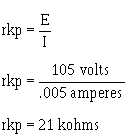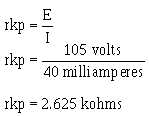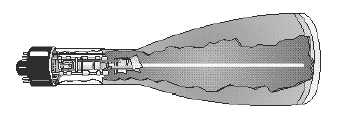2-18
In view C, the source voltage has been raised to 200 volts. This will cause more gas in the tube to
ionize and 40 milliamperes of current to flow through the tube. The increased ionization will lower the
resistance of the tube (rkp). Thus, the tube will still drop 105 volts. The tube’s resistance (rkp) at this time
will be equal to:
As you can see, increasing the current flow will cause more ionization in the tube and a
corresponding decrease in the tube’s resistance. Because of this, the tube will always have a constant
voltage drop between its plate and cathode throughout its operating range.
Q10.
What are two advantages that gas-filled tubes have over conventional electron tubes?
Q11.
Once ionization has occurred in a thyratron, what control does the control grid have over the
tube’s operation?
Q12.
What precautions should be exercised when using mercury-vapor thyratrons?
Q13.
Cold-cathode tubes can be used as voltage regulators because of what characteristic?
THE CATHODE-RAY TUBE (CRT)
Although you may not be aware of this fact, the CATHODE-RAY TUBE shown in figure 2-17 is,
in all probability, the one tube with which you are most familiar. Before you started your study of
electronics, you probably referred to cathode-ray tubes as picture tubes. The cathode-ray tube (CRT) and
the picture tube of a television set are one and the same.
Figure 2-17.—Cutaway view of a typical CRT.





